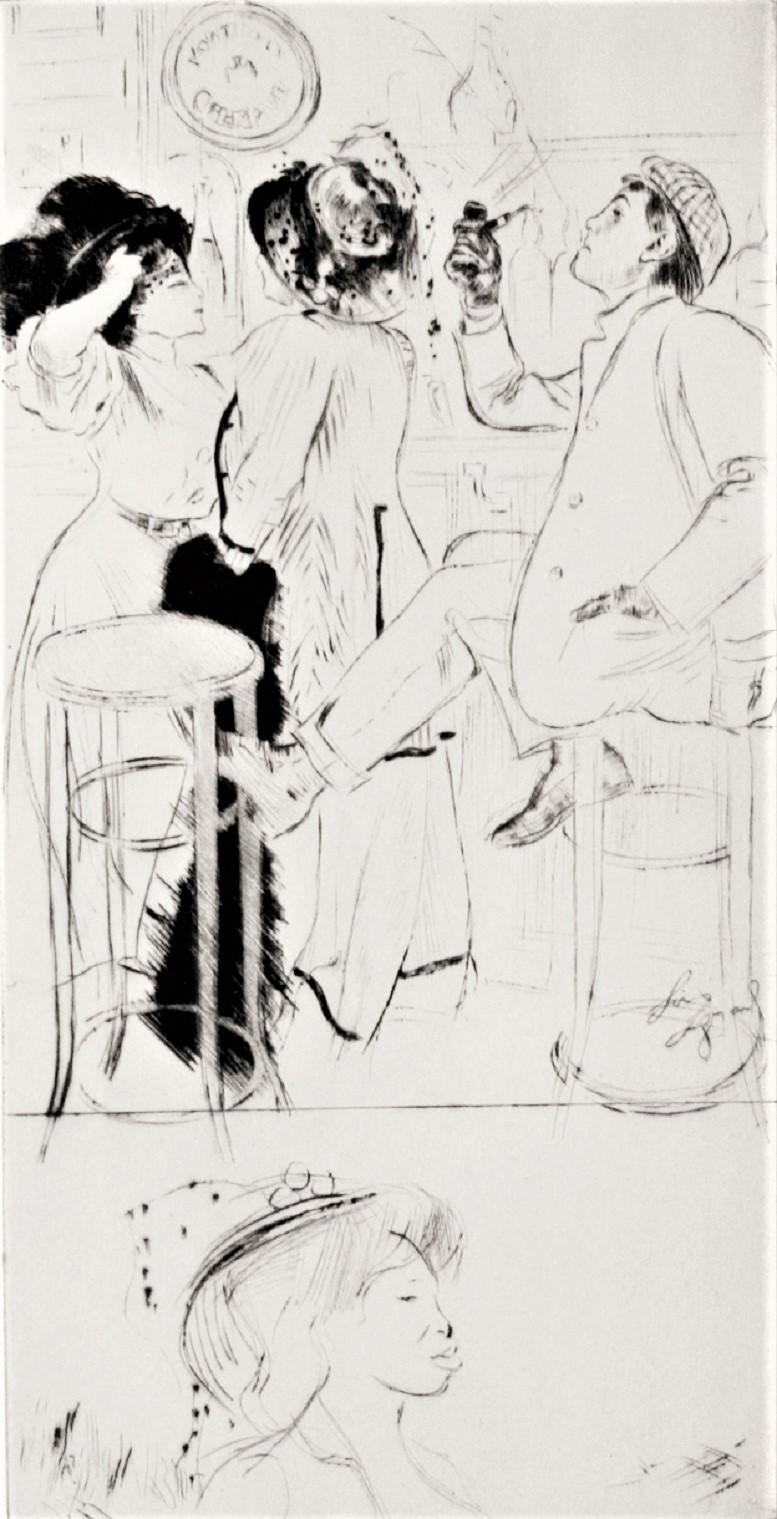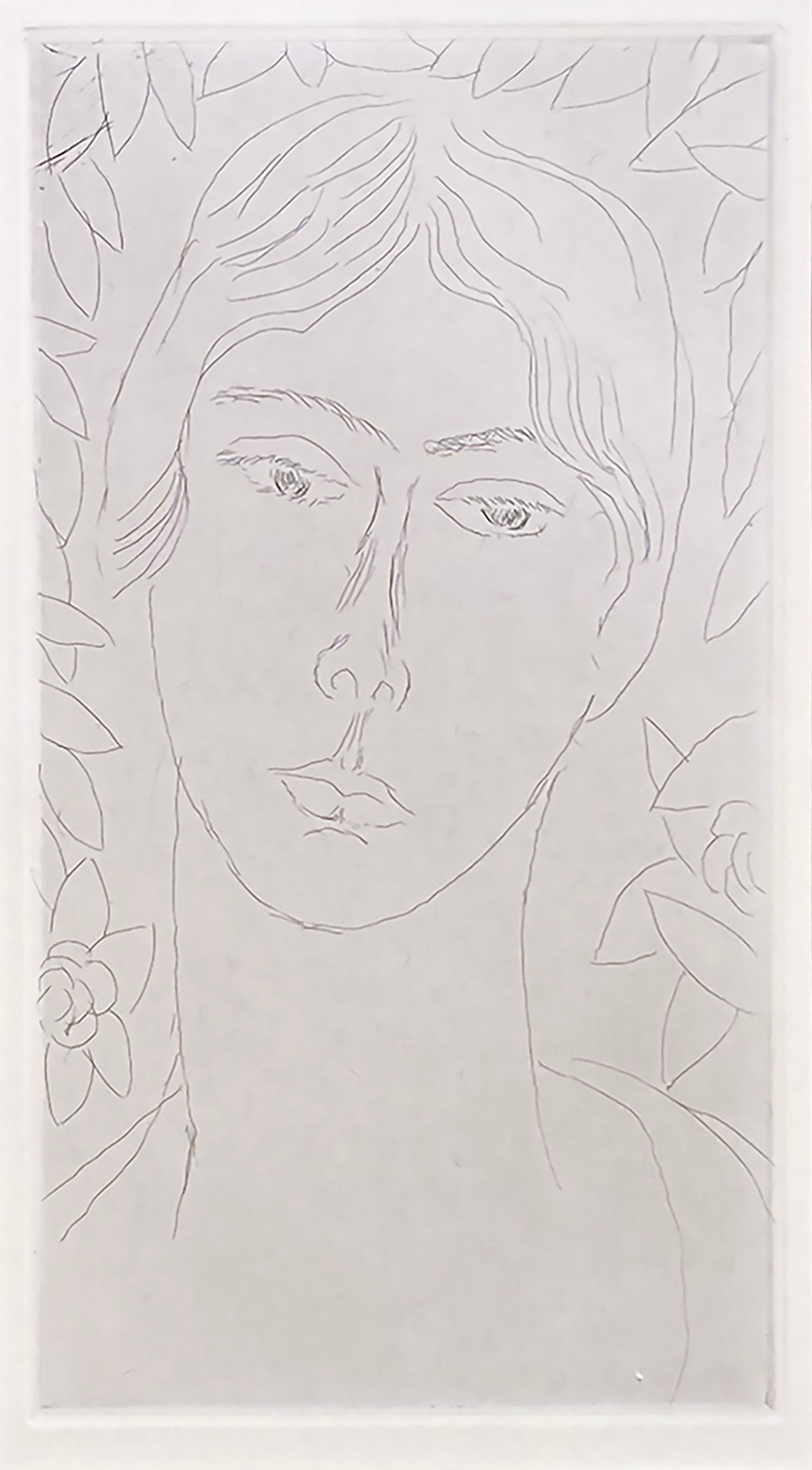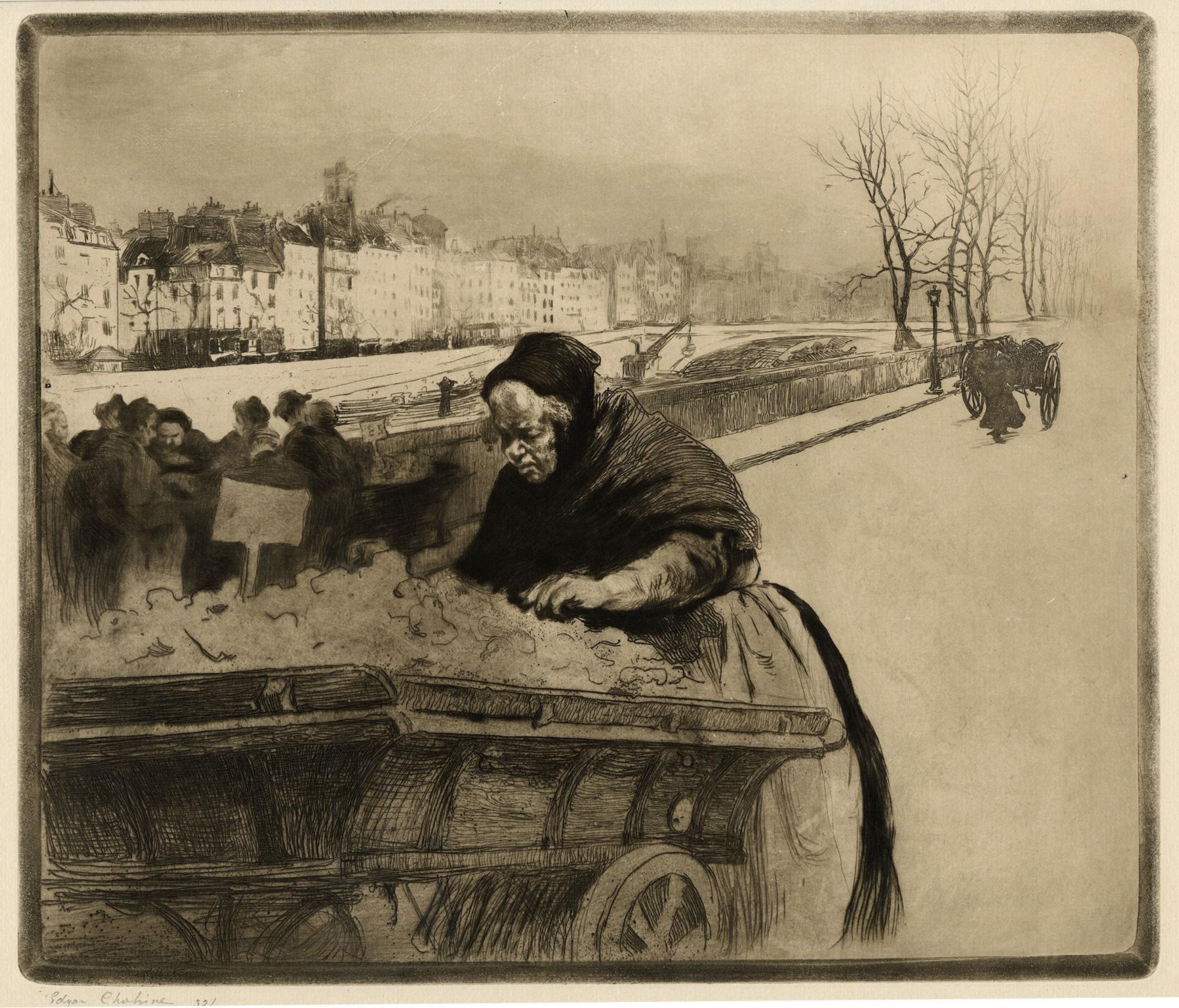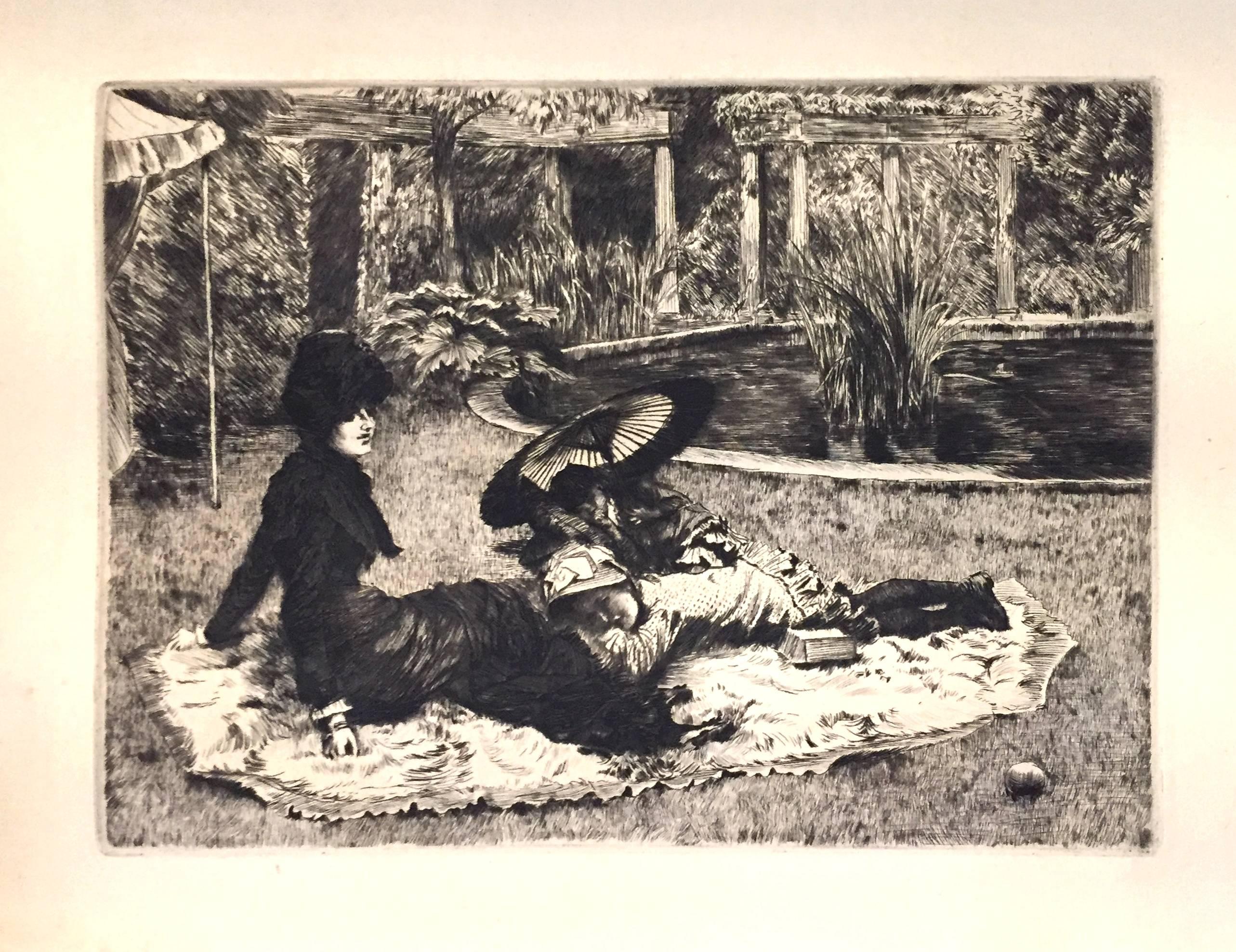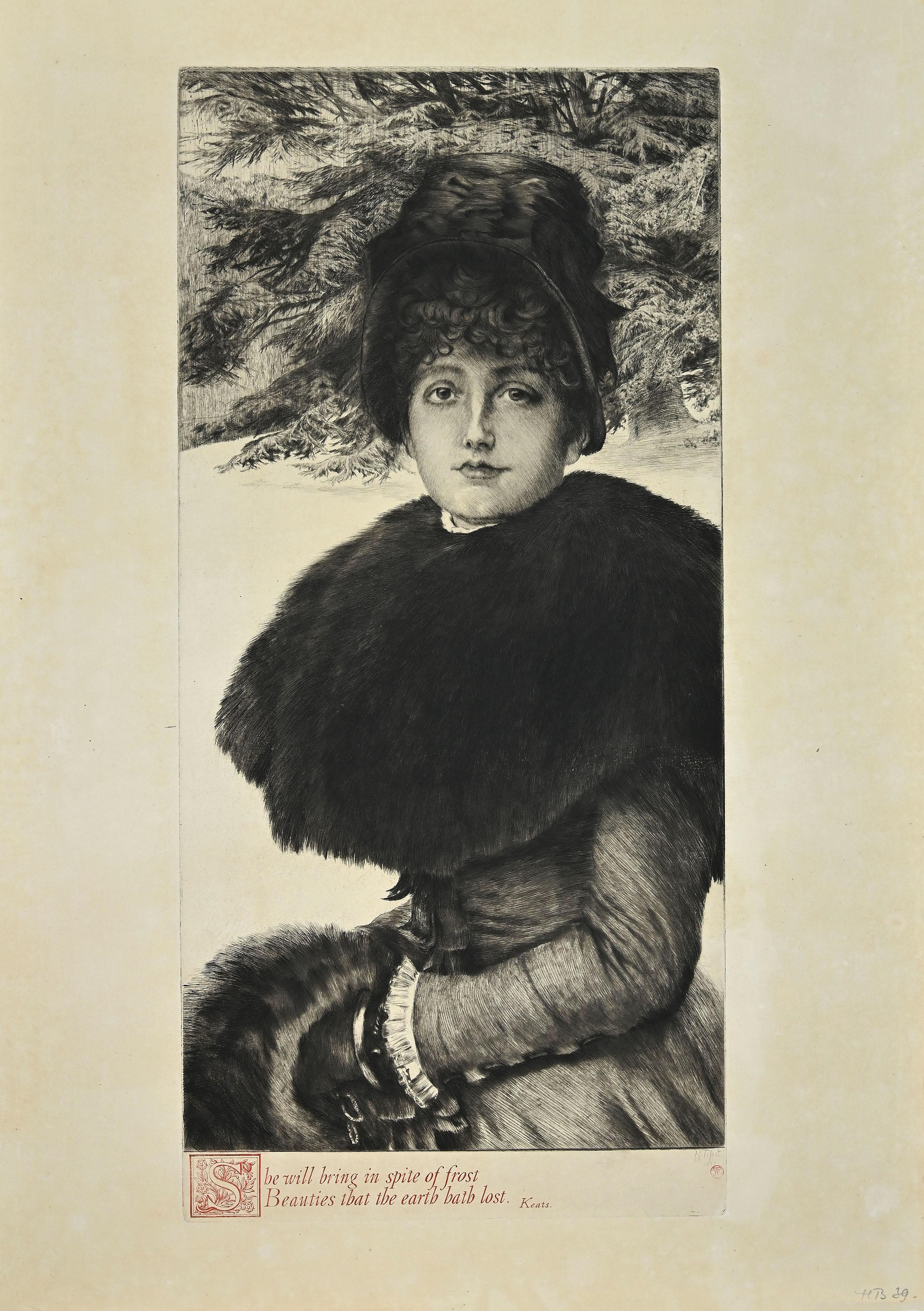Items Similar to La Loge (The Lodge) /// Post-Impressionist Figurative French Paris People Art
Want more images or videos?
Request additional images or videos from the seller
1 of 17
Louis LegrandLa Loge (The Lodge) /// Post-Impressionist Figurative French Paris People Art1911
1911
About the Item
Artist: Louis LeGrand (French, 1863-1951)
Title: "La Loge (The Lodge)"
Portfolio: Gazette des Beaux-Arts
*Issued unsigned, though signed by LeGrand in the plate (printed signature) lower left
Year: 1911
Medium: Original Drypoint Etching on cream wove paper
Limited edition: approx. 1,500
Printer: Unknown, Paris, France
Publisher: Gazette des Beaux-Arts, Paris, France
Reference: Sanchez & Seydoux No. 1911-6; Arwas No. 388 (IV/V)
Sheet size: 10.75" x 7"
Image size: 7.75" 5.5"
Condition: Light toning to sheet. It is otherwise a strong impression in excellent condition
Notes:
The portfolio name inscribed by LeGrand in the plate (printed) lower left. Printed in one color: black. This work was originally entitled "Prince K". Comes with its original cover tissue sleeve.
This etching was published by Gazette des Beaux-Arts. The Gazette des Beaux-Arts was a French art review, found in 1859 by Édouard Houssaye, with Charles Blanc as its first chief editor. Assia Visson Rubinstein was chief editor under the direction of George Wildenstein from 1928 until 1960. Her papers, which include all editions of the Gazette from this period, are intact at the Cantonal and University Library of Lausanne in Dorigny. The Gazette was a world reference work on art history for nearly 100 years - one other editor in chief, from 1955 to 1987, was Jean Adhémar. It was bought in 1928 by the Wildenstein family, whose last representative was Daniel Wildenstein, its director from 1963 until his death in 2001. The review closed in 2002.
Biography:
Legrand was born in the city of Dijon in the east of France. He worked as a bank clerk before deciding to study art part-time at Dijon's Ecole des Beaux-Arts. He won the Devosge prize at the school in 1883. In 1884 Legrand studied engraving under the Belgian printmaker Fe´licien Rops. Legrand's artworks include etchings, graphic art and paintings. His paintings featured Parisian social life. Many were of prostitutes, dancers and bar scenes, which featured a sense of eroticism. According to the Hope Gallery, "Louis Legrand is simply one of France's finest early twentieth century masters of etching." His black and white etchings especially provide a sense of decadence; they have been compared to those of Henri de Toulouse-Lautrec, though his drawings of the Moulin Rouge, the can-can dance and the young women of Montmartre preceded Toulouse-Lautrec's paintings of similar scenes. He made over three hundred prints of the night life of Paris. They demonstrate "his remarkable powers of observation and are executed with great skill, delicacy, and an ironic sense of humor that pervades them all."
Two of his satirical artworks caused him to be tried for obscenity. The first, "Prostitution" was a symbolic drawing which depicted a naked girl being grasped by a dark monster which had the face of an old woman and claws on its hands; the second, "Naturalism", showed the French novelist E´mile Zola minutely studying the thighs of a woman with a magnifying glass. Defended by his friend the lawyer Eugene Rodrigues, he was found not guilty in the lower court, but was convicted in the appeal court and then given a short prison sentence for refusing to pay his fine.
Legrand was made famous by his colour illustrations for Gil Blas magazine's coverage of the can-can, with text by Rodrigues (who wrote under the pseudonym Erastene Ramiro). It was a tremendous success, with the exceptional quantity of 60,000 copies of the magazine being printed and instantly sold out in 1891. In 1892, at the instigation of the publishing house Dentu, Legrand made a set of etchings of his Gil Blas illustrations. The etchings were published in a book, Le Cours de Danse Fin de Siecle (The End of the Century Dance Classes). Legrand took a holiday in Brittany, which inspired him to engrave a set of fourteen lithographs of simple country life called Au Cap de la Chevre (On Goat Promontory). It was published by Gustave Pellet who became a close friend of Legrand's. Pellet eventually published a total of 300 etchings by Legrand, who was his first artist; he also published Toulouse-Lautrec and Fe´licien Rops among others. Legrand did not only work in graphics; he exhibited paintings at the Paris salon of the Socie´te´ Nationale des Beaux-Arts starting in 1902. In 1906 he was made a chevalier of the Le´gion d'honneur. He died in obscurity in 1951. A retrospective exhibition was held at the Fe´licien Rops museum in Namur, Belgium in 2006 to celebrate Legrand's graphic art. The art collector Victor Arwas published a catalogue raisonne´ for the occasion.
- Creator:Louis Legrand (1863 - 1951, French)
- Creation Year:1911
- Dimensions:Height: 10.75 in (27.31 cm)Width: 7 in (17.78 cm)
- Medium:
- Movement & Style:
- Period:
- Condition:
- Gallery Location:Saint Augustine, FL
- Reference Number:1stDibs: LU1212621272
About the Seller
5.0
Platinum Seller
These expertly vetted sellers are 1stDibs' most experienced sellers and are rated highest by our customers.
Established in 1978
1stDibs seller since 2015
1,214 sales on 1stDibs
Typical response time: <1 hour
- ShippingRetrieving quote...Ships From: Saint Augustine, FL
- Return PolicyA return for this item may be initiated within 3 days of delivery.
More From This SellerView All
- Spring Song /// Antique Female Artist Children Child Etching British ArtBy Eileen SoperLocated in Saint Augustine, FLArtist: Eileen Alice Soper (English, 1905-1990) Title: "Spring Song" *Signed by Soper in pencil lower right Year: 1924 Medium: Original Etching on cream laid paper Limited edition: 178 Printer: Likely printed by Eva Soper, London, UK Publisher: H C Dickens, London, UK Reference: "The Catalogue Raisonne of Prints and Etchings of George and Eileen Soper" - Beetles No. 83, page 119, 141, 157 Sheet size: 8.13" x 10.13" Image size: 6.63" x 9.63" Condition: Paper trimmed in the margins. A few faint areas of discoloration. It is otherwise a strong impression in very good condition Notes: Provenance: private collection - Boulder, CO. Biography: Eileen Soper was born in 1905 in the Municipal Borough of Enfield and moved to the house where she was to spend the rest of her life in Harmer Green, Welwyn in the Hertfordshire countryside in 1908. The house she later named "Wildings" was built by her father, the artist George Soper...Category
1920s Modern Figurative Prints
MaterialsIntaglio, Drypoint, Laid Paper, Etching
- Portrait de Fanny Charrin /// French Impressionist Art Nouveau Lady Woman GirlLocated in Saint Augustine, FLArtist: Malo-Renault (French, 1870-1938) Title: "Portrait de Fanny Charrin" Portfolio: Gazette des Beaux-Arts *Issued unsigned Year: 1909 Medium: Original Etching and Drypoint on wov...Category
Early 1900s Baroque Figurative Prints
MaterialsIntaglio, Drypoint, Etching
- The New Testament /// Old Masters Biblical Religious Engraving Dutch Angel ArtBy Michael BurghersLocated in Saint Augustine, FLArtist: Michael Burghers (Dutch, c.1647/1648-1727) Title: "The New Testament" Portfolio: Holy Bible *Signed by Burghers in the plate (printed signature) lower left Year: 1680 Medium: Original Etching and Engraving with recent Hand-Color on watermarked laid paper Limited edition: Unknown Printer: John Baskett, London?, UK Publisher: Moses Pitt, Peter Parker, and Thomas Guy, London?, UK Sheet size (irregular margins): 17.25" x 10.5" Image size: 14.75" x 9.5" Condition: Uneven trimming and light edgewear in margins. One small tear entering image lower right which has been skillfully repaired with added backing paper with archival tape from verso. It is otherwise a strong impression in very good condition with strong colors Very rare Notes: Provenance: private collection - Cotswolds, UK. Comes from the 1685 "Holy Bible" portfolio. John Baskett was deemed printer to the King's most Excellent Majesty, for Great Britain and to the University of Oxford. Large unidentified watermark within center of sheet. There is an example of this work in the permanent collection of the British Museum in London, UK. In the foreground, John the Evangelist, holding a pen and writing...Category
1680s Old Masters Figurative Prints
MaterialsWatercolor, Engraving, Etching, Laid Paper, Intaglio
- Frère Ogrin, l'hermite (Brother Ogrin, the Hermit) /// Surrealism Salvador DaliBy Salvador DalíLocated in Saint Augustine, FLArtist: Salvador Dali (Spanish, 1904-1989) Title: "Frère Ogrin, l'hermite (Brother Ogrin, the Hermit)" Portfolio: Tristan et Iseult *Monogram signed by Dali in pencil lower right Year: 1970 Medium: Original Engraving on Mandeure paper Limited edition: 101/125 Printer: Atelier Rigal, Paris, France Publisher: Leon Amiel, New York, NY and Paris, France Reference: "The Official Catalog of the Graphic Works of Salvador Dali" - Field No. 70-10-K, page 60; "Dali: Catalogue Raisonné of Etchings and Mixed-Media Prints, 1924-1980" - Michler/Löpsinger No. 416, page 183-184 Framing: Recently framed in a gold ornate moulding with matting from Holland, gold filet, and Museum glass. All archival Framed size: 28" x 22.25" Sheet size (folded): 18" x 12.75" Sheet size (unfolded): 18" x 25.5" Image size: 15.75" x 10.5" Condition: One tiny tear upper left. Some faint spots lower left. It is otherwise a strong impression is excellent condition Notes: Provenance: private collection - Indianapolis, IN; acquired from Ferdinand Roten Galleries, Baltimore, MD retaining their original gallery label on verso. Numbered by Dali in pencil lower left. Comes from Dali's 1970 "Tristan et Iseult" portfolio of 21 color engravings. Leon Amiel chop mark/blind stamp lower left. These engravings from the "Tristan et Iseult" portfolio were printed on folded sheets with their respective text descriptions as issued. We are specialists in Salvador Dali's printmaking oeuvre, having personally worked with his cataloger Albert Field in the 1980's, we unconditionally guarantee all of our examples to be authentic. Biography: Salvador Dalí (May 11, 1904 – January 23, 1989), was a prominent Spanish Catalan surrealist painter born in Figueres, Spain. Dalí was a skilled draftsman, best known for the striking and bizarre images in his surrealist work. His painterly skills are often attributed to the influence of Renaissance masters. His best-known work, The Persistence of Memory, was completed in August 1931. Dalí's expansive artistic repertoire included film, sculpture, and photography, in collaboration with a range of artists in a variety of media. Dalí attributed his "love of everything that is gilded and excessive, my passion for luxury and my love of oriental clothes...Category
1970s Surrealist Figurative Prints
MaterialsEngraving, Intaglio
- Piquier Allemand (German Pikeman) /// Old Masters Figurative Man Soldier AntiqueLocated in Saint Augustine, FLArtist: Armand Joseph Lallemand (French, 1810-1871) Title: "Piquier Allemand (German Pikeman)" Portfolio: Gazette des Beaux-Arts Year: 1866 Medium: Original Etching on cream laid pap...Category
1860s Old Masters Figurative Prints
MaterialsIntaglio, Etching, Laid Paper
- Le Bouquet de Violettes (The Bouquet of Violets) /// Figurative ImpressionistBy Manuel RobbeLocated in Saint Augustine, FLArtist: Manuel Robbe (French, 1872-1936) Title: "Le Bouquet de Violettes (The Bouquet of Violets)" *Signed by Robbe in pencil lower right Year: 1903 Medium: Original Hand-Colored Etc...Category
Early 1900s Impressionist Figurative Prints
MaterialsEtching, Aquatint, Watercolor, Laid Paper, Intaglio
You May Also Like
- SportsmenBy Louis LegrandLocated in Storrs, CTSportsmen. 1908. Etching and drypoint. Exsteens 271.i/ii. 11 1/4 x 5 3/4 (sheet 17 3/8 x 12 1/4). Series: Les Bars. From the first state edition of 30 proofs with the remarque sketch...Category
Early 1900s Post-Impressionist Figurative Prints
MaterialsDrypoint, Etching
- "Mlle Landsberg" (grade planche, pl. 16)By Henri MatisseLocated in Missouri, MO"Mlle Landsberg" (grade planche, pl. 16), 1914 Henri Matisse (French, 1869-1954) Signed and Numbered Lower Right Edition 12/15 Image size: 7 7/8 x 4 5/16 inches Sheet size: 17 11/16 x 12 1/2 inches With frame: 19 1/2 x 14 1/2 inches Henri Matisse came from a family who were of Flemish origin and lived near the Belgian border. At eight o'clock on the evening of December 31, 1869, he was born in his grandparents' home in the town of Le Cateau in the cheerless far north of France. His father was a self-made seed merchant who was a mixture of determination and tightly coiled tension. Henri had no clear idea of what he wanted to do with his life. He was a twenty-year-old law clerk convalescing from appendicitis when he first began to paint, using a box of colors given to him by his mother. Little more than a year later, in 1890, he had abandoned law and was studying art in Paris. The classes consisted of drawing from plaster casts and nude models and of copying paintings in the Louvre. He soon rebelled against the school's conservative atmosphere; he replaced the dark tones of his earliest works with brighter colors that reflected his awareness of Impressionism. Matisse was also a violinist; he took an odd pride in the notion that if his painting eye failed, he could support his family by fiddling on the streets of Paris. Henri found a girlfriend while studying art, and he fathered a daughter, Marguerite, by her in 1894. In 1898 he married another woman, Amelie Parayre. She adopted the beloved Marguerite; they eventually had two sons, Jean, a sculptor and Pierre who became an eminent art dealer. Relations between Matisse and his wife were often strained. He often dallied with other women, and they finally separated in 1939 over a model who had been hired as a companion for Mme. Matisse. She was Madame Lydia, and after Mme. Matisse left, she remained with Matisse until he died. Matisse spent the summer of 1905 working with Andre Derain in the small Mediterranean seaport of Collioure. They began using bright and dissonant colors. When they and their colleagues exhibited together, they caused a sensation. The critics and the public considered their paintings to be so crude and so roughly crafted that the group became known as Les Fauves (the wild beasts). By 1907, Matisse moved on from the concerns of Fauvism and turned his attention to studies of the human figure. He had begun to sculpt a few years earlier. In 1910, when he saw an exhibition of Islamic art, he was fascinated with the multiple patterned areas and adapted the decorative universe of the miniatures to his interiors. As a continuation of his interest in the "exotic", Matisse made extended trips to Morocco in 1912 and 1913. At the end of 1917, Matisse moved to Nice; he would spend part of each year there for the remainder of his life. A meticulous dandy, he wore a light tweed jacket amd a tie when he painted. He never used a palette, but instead squeezed his colors on to plain white kitchen dishes...Category
1910s Fauvist Figurative Prints
MaterialsEtching, Drypoint
- La Marchande des Quatres-SaisonsBy Edgar ChahineLocated in Middletown, NYEtching with drypoint on cream wove paper, 11 3/4 x 13 3/4 inches (297 x 347 mm), full margins. Signed in pencil and numbered 32/40, lower margin. Minor mat tone and several small lo...Category
Early 20th Century Post-Impressionist Portrait Prints
MaterialsHandmade Paper, Rag Paper, Drypoint, Etching
- On the Grass - Etching and Drypoint by J. Tissot - 1880By James TissotLocated in Roma, ITVery fine print on verge crème. Some small traces of oxidation, dust and some flowerings on external edges of sheet, otherwise excellent conditions. Full margins. Ref. Wentworth 50.Category
1880s Post-Impressionist Landscape Prints
MaterialsDrypoint, Etching
- Promenade dans la Neige - Etching by J. Tissot - 1880By James TissotLocated in Roma, ITBeautiful print on verge crème, 2° state on 3, with letters printed in red. Stamp “Lugt 1545”. Little crack and fold on lower left margin of the sheet. Some small traces of oxidati...Category
1880s Post-Impressionist Portrait Prints
MaterialsDrypoint, Etching
- Jean Francois Millet, "La Boullie (The Porridge)", Drypoint Etching, 1861By Jean François MilletLocated in Long Island City, NYEtching printed in brownish black on light tan Chine collé, 1861. Image measures 6 x 5 inches, displayed in a 15.5 x 12.5 inch frame. Etched signature and date lower left. A very goo...Category
1860s Impressionist Figurative Prints
MaterialsDrypoint, Etching, Intaglio
